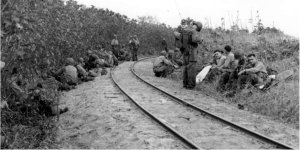The Pacific War Online Encyclopedia: Railroads (original) (raw)
| ![]() The Pacific War Online Encyclopedia | |
| -------------------------------------------------------------------------------- | |
The Pacific War Online Encyclopedia | |
| -------------------------------------------------------------------------------- | |
U.S. Army. Viaibiblio.org
Railroads are the most economical land-bound form of transportation. Significant civil engineering effort is required to construct the rail bed, but this investment is usually quickly amortized by the volume of traffic that the rails can carry. Total mileage of railroads was a useful indicator of the overall economic development of a region; it follows that much of the South and Southwest Pacific areas had litle railroad infrastructure. China also lacked railroads, with just a few major north-south and east-west lines dictating the avenues of advance of the Japanese Army, which was highly reliant on rail transport.
The Japanese built the Burma-Siam railroad using slave labor in just under a year, working from both ends to the middle over a distance from each end of 129 miles (208 km) for a rate of construction of about 0.4 miles (0.6 km) per day. Construction rates could be much greater in easier terrain with more modern equipment and professional labor (up to 10 miles per day), and much less in very difficult terrain requiring bridging or tunneling.
Like ships, rail cars spend a significant fraction of their time being loaded and unloaded. The United States Army estimated that the average movement of rail cars in the United States during the war was 51.7 miles per day, including days spent at sidings. Interservice cooperation to ensure rail cars were fully loaded for movement, by combining cargoes, was relatively good in the United States. I have no information for Japan, but based on the lack of interservice cooperation over merchant shipping and factory space, I suspect such cooperation was nonexistent.
It took 63 trains totalling 1882 cars to move an infantry division and all its equipment in the United States. Corresponding figures for an armored division were 69 trains totaling 2221 cars. A Japanese division would likely have required considerably less rolling stock, both because the division was generally smaller and less heavily equipped, and because the Japanese would likely tolerate a considerably higher level of discomfort in the troops.
The maximum traffic that could be moved over a rail line depended both on the quality of the line and the availability of rolling stock. An American freight car could carry an average of about 35 tons. An American division slice plus two air wing slices (50,000 men) required 1600 tons of supplies per day, which could be carried by a single daily train of about 45 box cars. Thus even a single rail line with limited rolling stock could support a considerable military force.
The American rail system was extensive, but the rail companies had suffered in the Great Depression and a third of all mileage was in or just coming out of receivership. Serviceable rail cars had declined in numbers by 30% since 1929 due to reduced demand. Rail owners were reluctant to invest in new equipment during the defense buildup of 1939-1941 for fear of being stuck with excess capacity once the emergency had passed, but the government estimated that at least 100,000 new cars were needed immediately and another 400,000 in the longer term. However, the rail lines surprised observers by successfully handling in excess of 900,000 cars per week for seven straight weeks in the autumn of 1941. Creation of the Office of Defense Transportation (ODT) was authorized on 18 December 1941, under the leadership of Joseph Eastman, a former commissioner of the Interstate Commerce Commission who was on good terms with the railroads and shared their desire to keep the railroads from being nationalized. By pooling warehouses and coordinating rail traffic, ODT was able to produce "a stunning improvement in performance" (Klein 2013). At the start of 1942, there were only about 120,000 tanker cars in service; by year's end, 27.965 tank cars were supplying 94.995 barrels of oil weekly to the East Coast, an impressive performance. By July 1942 the railroads were carrying 80% more passengers and freight than in 1939 with less equipment and at enough of a profit to begin paying down their debts.
An important innovation was CTC or Centralized Traffic Control, which had made its debut on the Southern Pacific in 1931. CTC was an electrical control system that gave dispatchers unprecedented control over rail traffic by reporting the exact location of each train and providing remote control of all signals and switches. This increased a track's capacity by 50%, but cost $15,000 a mile in install. Southern Pacific was also compelled to break down old employment barriers (against Hispanics and native Americans) to have enough manpower to run its rail cars and its older, non-automated, classification yards.
Allied intelligence estimated that Japan proper had 6,300 locomotives, 120,000 freight cars, and 16,000 passenger cars, on a rail network of 3'6" (106.7 cm) gauge.Korea had some 600 locomotives, 7500 freight cars, and 1500 passenger cars running on standard gauge (4' 8.5" or 143.5 cm). The Korean rail system was continuous with the Manchurian system. Japanese freight cars could carry an average of 13 tons and passenger cars could carry 64 passengers. Those in Korea could carry 30 tons or 100 passengers, reflecting the greater gauge. The Japanese rail system could dispatch one train per hour on the main trunk lines and about half that on branch lines, and trains traveled at about 15 miles per hour (24 km/h) on Japanese trunk lines or 20 miles per hour (32 km/h) on Manchurian lines. Branch lines operated at 10 to 12 miles per hour (16-19 km/h).
Because of their great logistical importance, this Encyclopedia lists the railroad connections between points of interest discussed in the Encyclopedia.
References
"Handbook on Japanese Military Forces" (1944-9-15)
"The War Against Japan" (1952; accessed 2013-7-27)
The Pacific War Online Encyclopedia © 2013-2014, 2016 by Kent G. Budge. Index

